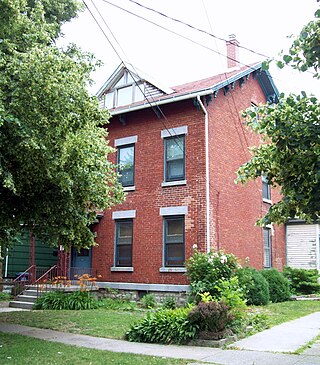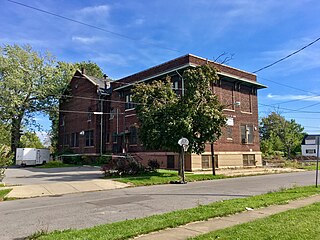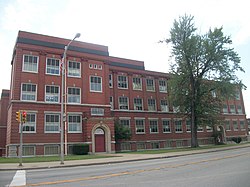
The Mentholatum Company, Inc. is a maker of non-prescription health care products founded in 1889 by Albert Alexander Hyde in the United States. It was bought out by Rohto Pharmaceutical Co., a Japanese health care company, in 1988. The Mentholatum Company is known for its top three products, Mentholatum Ointment, Mentholatum Deep Heating Rub, and Mentholatum Lip Care. The Mentholatum Company also produces Fletcher's Laxative a product line purchased in 1984, from Sterling Drug. The Mentholatum Building in Buffalo, New York, was listed on the National Register of Historic Places in 2017.

The Buffalo Electric Vehicle Company was an American electric car manufacturing company from 1912 until 1915 located at 1219-1247 Main Street in Buffalo, New York. The motorcars were marked under the Buffalo brand. The company was formed by a merger of several electrical vehicle and allied companies which included:

St. Cecilia Church is a Roman Catholic parish church in the Roman Catholic Archdiocese of New York and a historic landmark located at 120 East 106th Street between Park Avenue and Lexington Avenue, Manhattan, New York City, New York. The parish was established in 1873. It was staffed by the Redemptorist Fathers from 1939 to 2007. The church was designated a New York City landmark in 1976. The church and convent were listed on the U.S. National Register of Historic Places in 1984.

This is a list of the National Register of Historic Places listings in Pine County, Minnesota. It is intended to be a complete list of the properties and districts on the National Register of Historic Places in Pine County, Minnesota, United States. The locations of National Register properties and districts for which the latitude and longitude coordinates are included below, may be seen in an online map.

First Unitarian Universalist Church of Niagara is a historic church located at Niagara Falls in Niagara County, New York. It was constructed in 1921 in a Classical Revival style. The steel and concrete church is faced with rough, uncut limestone from the bedrock excavated for the building's foundation.

Blessed Trinity Roman Catholic Church Buildings is a historic Romanesque revival Roman Catholic church complex located at Buffalo in Erie County, New York. It is part of the Diocese of Buffalo.

Annunciation School is a historic parochial school building located at Buffalo in Erie County, New York. It was built in 1928 and is an I-shaped brick structure representative of standardized, modestly sized school buildings of the period. It was operated by the Sisters of St. Mary of Namur. The school was closed as a parish school in 1988. It was home to the Catholic Academy of West Buffalo until 2005 and was converted to apartments in 2009–2010.

County and City Hall, also known as Erie County Hall, is a historic city hall and courthouse building located at Buffalo in Erie County, New York. It is a monumental granite structure designed by Rochester architect Andrew Jackson Warner and constructed between 1871 and 1875, with its cornerstone being laid on June 24, 1872. The building has four floors and features a 270-foot high clock tower.

M. Wile and Company Factory Building is a historic garment factory located at Buffalo in Erie County, New York. It is an early and significant example of the "Daylight Factory." The four-story building, erected in 1924, is constructed of reinforced concrete and features curtain walls of metal sash windows. It was home to M. Wile & Company until 1999; a major manufacturer of men's suits, founded by Mayer Wile in Buffalo in 1877. In 1969, the company became a subsidiary of Hartmarx.

The Architecture of Buffalo, New York, particularly the buildings constructed between the American Civil War and the Great Depression, is said to have created a new, distinctly American form of architecture and to have influenced design throughout the world.

Alling & Cory Buffalo Warehouse is a historic warehouse building located at Buffalo in Erie County, New York. It consists of a six-story, L-shaped, 120,000-square-foot (11,000 m2) former paper warehouse building built in 1910-1911 for the Alling & Cory company of Rochester, with a one-story, brick loading dock addition built in 1926. It is built of reinforced concrete with classical detailing and considered to be of the "Daylight Factory" design. The building has been rehabilitated into an apartment complex.

Holy Trinity Roman Catholic Church Complex is a historic Polish, Roman Catholic and former church located at Niagara Falls in Niagara County, New York within the Diocese of Buffalo.

The Dayton House is a historic home located at 243 Dearborn Street, in the Black Rock neighborhood of Buffalo, Erie County, New York.

Public School No. 60, also known as Riverside Academy, is a historic school building located in the Riverside neighborhood of Buffalo, Erie County, New York. The original section was built in 1897, and is a three-story, 12 bay, "I"-plan red brick building with Renaissance Revival detailing. It sits on a raised basement and features polychrome, stepped façade, quoining, and classical entrances. A substantial three-story rear addition was built in 1922 and includes an auditorium. The building has been converted to accommodate 68 units of affordable housing.

Public School No. 63, also known as Campus North School, is a historic school building located in the Kensington-Bailey neighborhood of Buffalo, Erie County, New York. The original section was built in 1917, and is two stories above a ground floor, giving the appearance of a three-story red brick building with Classical Revival detailing. The original H-shaped plan consisted of classrooms located in the wings, with gymnasium, swimming pool and auditorium located centrally. Northeast and northwest corner additions were built in 1925. The building is an example of a typical standardized public school plan developed by city architect Howard L. Beck. The school has been redeveloped as an apartment building known as The Lofts at University Heights.

Buffalo Public School No. 24, also known as Public School 59, is a historic school building located in the Broadway-Fillmore neighborhood of Buffalo, Erie County, New York. The original section was built in 1901, and is a three-story, seven-bay, I-shaped, red brick building over a raised basement with Renaissance Revival detailing. The building incorporates sandstone, terra cotta, and pressed metal details. It was the first school to offer special education within the City of Buffalo school system. The school has been redeveloped as an apartment building.

Buffalo Public School No. 77 is a historic school building located in Buffalo, Erie County, New York. It was built in 1927, and is a three-story, rectangular, brick building with Classical Revival detailing. It has a courtyard plan with a double-height gymnasium at one end and a double-height auditorium at the other. The building is an example of a typical standardized public school plan developed by Ernest Crimi. The school building has been redeveloped as senior housing and a neighborhood community center.

Westminster House Club House is a historic settlement house clubhouse located in the Broadway-Fillmore neighborhood of Buffalo, New York, United States. It was built in 1909–1910, and is a two-story, L-shaped, red brick building with Craftsman style design elements. It features broad overhanging eaves with paired brackets and a raised basement. The building is the last of a complex of buildings operated by Westminster Presbyterian Church that housed social welfare activities that largely benefited the German immigrant community on Buffalo's East Side in the early 20th century.

Buffalo Public School No. 57, also known as Broadway Village Elementary Community School, is a historic school building located in the Broadway-Fillmore neighborhood of Buffalo, Erie County, New York. It was built in 1914, and is a three-story, red brick building over a full basement with Classical Revival detailing. It is connected to a one-story auditorium building by a one-story hyphen. The building was originally constructed as an addition to the original 1897 Public School No. 57, which was demolished in 1960. The school has been redeveloped as a multi-use facility including apartments, offices, and a community center.























